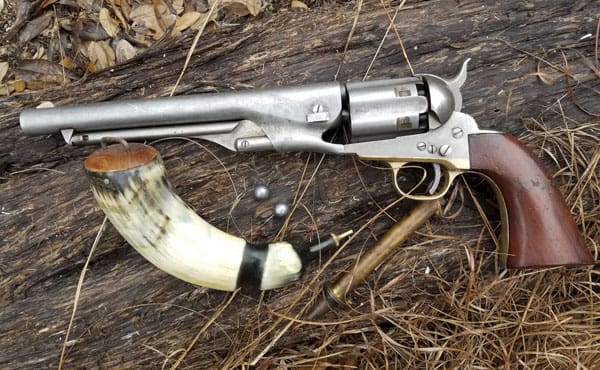
“And this is the McCulloch, Cimarron’s reproduction of the 1860 Colt that Ben McCuloch had smuggled into Texas just after secession.”
“Dean, you had me at McCulloch.” And that, my ballistic besties, is how Jon Wayne Taylor blows cash on guns. Although I’m a flintlock fanatic, I’ve never been much of a cap and ball shooter. But this one sparked my imagination, as the name is intertwined with my youth and my home.
I grew up in the northern part of Hays County, named after Captain Jack Coffee Hays, the most famous (real life) Texas Ranger of all time, and the man who reinvented gun fighting. Onion Creek was the waterway that defined my childhood. Its limestone bottoms and clear, cool waters made up the swimming holes and fishing streams of my youth. One of those swimming holes is know as “The Rope Swing” at Camp Ben McCulloch.
Some of the best times in my life were spent there, swinging off that rope swing, dancing with girls at the annual Confederate Reunion, and having a few beers with friends during high school. Nowadays, at least two of the three of those would likely get me killed.
While history wasn’t among my primary interests in those days, I would have been fascinated by the man whose name adorned the sign out front and was associated with my new revolver. Ben McCuloch, Ranger and general, would have been worth knowing about. Fortunately my interests broadened over time and Texas history, specifically Texas Ranger history, became one of them. I now sit on the board of directors of the Texas Ranger Foundation Association.
Long before he died for the Confederacy in Arkansas, Ben McColluch set off from Tennessee with his brother Henry and his friend, David Crocket (yes, that David Crocket), in the hopes of joining the Texas revolution. Fortunately for the Lone Star State, McCulloch came down with the measles while in east Texas, delaying him by weeks. That illness surely saved him from dying at what was later called the Thermopylae of the west. Within a couple of years he would end up serving as a lieutenant in the Texas Rangers directly under Captain Hays himself.
Hays would change western warfare forever, to the immediate benefit of frontier Texans. Prior to Hays, the common tactic for infantry and cavalry troops alike was to dismount and fire their almost exclusively single-shot rifles at the circling natives. The Comanches and Kiowas would remain on horseback, firing five highly effective arrows in the amount of time their opponents could take a single shot and reload.
Once Hays found the Colt Patterson Revolver, he used it to put the Rangers on an even footing with his enemy. Riding directly into groups of (primarily) Comanches, the Hays Rangers would get as close as possible before emptying their revolvers, then pulling another one (or two) from their pommel holsters to fire again.
Very soon after, Ranger Captain Sam Walker would meet directly with Sam Colt, creating what would be known as the Walker Colt. The timing could not have been better for Colt. His company was rapidly failing, and the Rangers’ order, and famous use of his revolvers, would be the savior of his company.
Under Hays, McCulloch saw first-hand the effectiveness of the close quarters, rapid fire style of fighting from horseback with a handgun. In fact, the Texas Rangers’ reliance on the Colt was one of the very few examples in history where a military unit used a handgun as their primary arm during an assault. The technique of the mounted revolver would remain with those early Rangers for the rest of their lives. For the next two decades, Ben McCulloch would enter combat not armed with a rifle, but with a shotgun and a brace of single-action revolvers.
Captain McCulloch’s life would change after Texas’s ill-fated secession. The Union would quickly form a blockade to keep the southern states from obtaining the necessary arms and materiel. But beyond Texas’s participation in the Civil War, the longer lasting, and likely more pressing concern to her citizens was the ongoing war with the Comanches.
Badly needing weapons, and while the blockade was in full force, McCulloch reached out to Sam Colt again and ordered 2,000 of his 1860 fluted cylinder revolvers. Mr. Colt remembered what the Rangers had done for him years before, saving his business and catapulting him to fame. One thousand of the revolvers were smuggled through Cuba, and New Orleans to be received directly by Ben’s brother Henry.
These .44 caliber cap and ball revolvers would send a 140gr round ball at 1,000fps and were the newest, and most advanced weapons Colt produced at the time. They represented the evolution of the weapon, much of that taken directly from the experience of the Texas Rangers themselves.
The Walker Colt threw the same ball another 200fps faster or more, but the Rangers must have decided that a pistol that would not be equaled in power for another 80 years (by the .357 magnum) was too much of a good thing when most of their shots were within 20 paces, and at a gallop. The McCulloch was almost half the weight of the four and a half pound Dragoon, and would still reliably kill a man at 75 yards. I’m sure they were very welcome to the Rangers, but some, if not most, certainly ended up in the Confederacy. Some, like Ben McCulloch, who would become officers under the Stars and Bars.
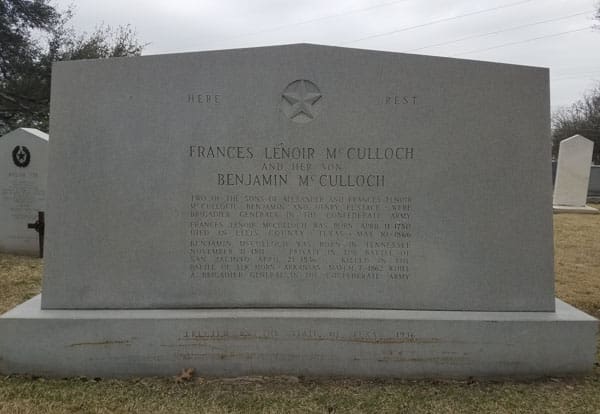
After years of great service in Texas, but less than a single year after joining the Confederacy, Major Ben McCulloch died while on a scouting mission in Arkansas. Sadly I can find no record of what his armaments were at that time in order to determine if one of the revolvers he would become associated with filled his hand at that time. In fact, any existing examples of those original revolvers proved very difficult to find.
After the war was over, of the 1,000 McCulloch revolvers originally ordered, only 280 were returned by the Rangers and lawmen they were assigned to, and of those, only 80 were in working order. It seems the Texans had, once again, little desire to return the arms given to them by their government. You would have thought their quartermaster would have learned a lesson from the town of Gonzales. That has made the McCulloch Colt exceedingly rare.
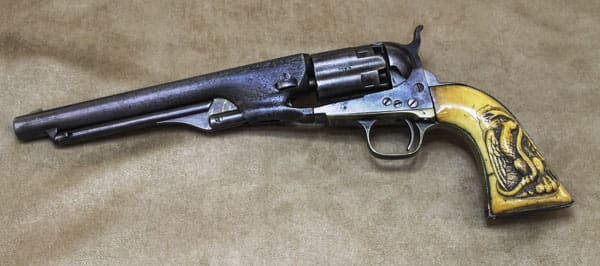
Fortunately, the Texas Ranger Museum and Hall of Fame in Waco, Texas would prove to be a valuable resource. Perusing the museum, which is an absolute must for anyone living in Texas or simply traveling Interstate 35, I found one sole surviving 1860 Army full fluted cylinder Colt. The museum was very helpful, and agreed to uncase the revolver for inspection and photographs so that I could compare it to my reproduction.

This original had one significant alteration, the addition of a carved ivory handle, bearing the common theme of an eagle holding a snake, perched on a cactus. The museum had little to no details on the revolver. They had received it from a local family, but no longer had any other information on the gun.
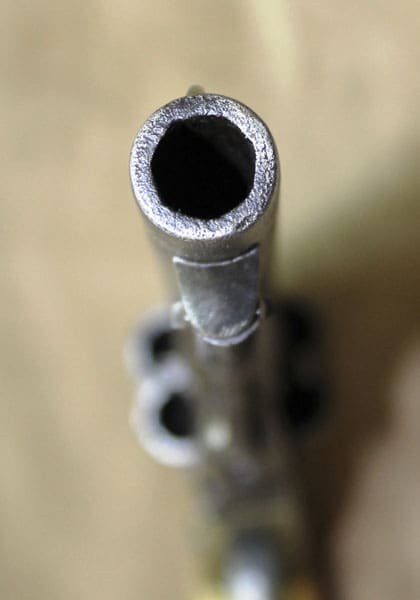
Other than the altered handle, and wear at the muzzle, the original was extremely similar to my reproduction. All of the lines, materials, screws, and operation of both the guns were the same. The “antiqued” finish on my reproduction almost perfectly mirrored this original. It appears that little antiquing was actually done, as every photo and drawing of the originals, as well as the one I was looking at, bore the same faded satin finish as the one I had purchased.
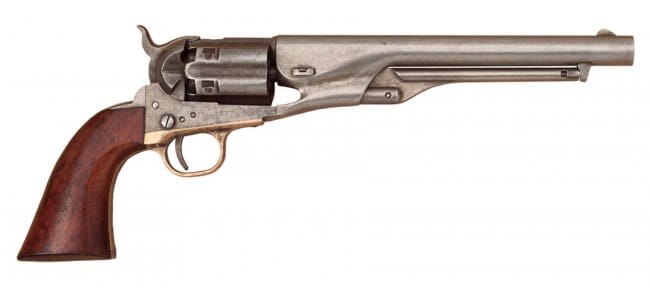
My new pistol was a reproduction made by Uberti of Italy, and imported by Cimarron Firearms and sold to me by Texas Jack’s out of Fredricksburg, Texas. Now that I knew it matched the originals in feel and appearance, I wanted to know how well it really shot, and if it could match the charge and fabled accuracy of the original.
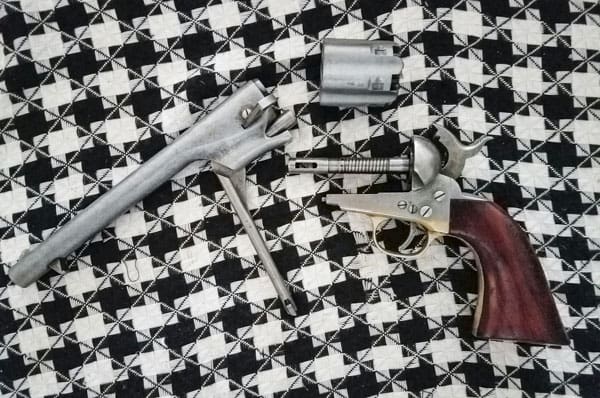
Following the instructions of the Cimarron manual, I cleaned the revolver fully, as well as shot a cap without a charge through each cylinder prior to loading any powder or ball. After that, I got right to it, filling each chamber with 25 grains of FFFg. I shot 20 rounds that first outing, thoroughly enjoying the pistol. The weight and balance of the gun is outstanding and with that charge the recoil is nothing at all. For an 8” barrel, it’s just nothing to point and shoot.
Single handed firing into a sillohete at 25 yards was an absolute breeze. I didn’t have a shot-trained horse available, but walking and firing at a brisk pace, as long as you know where to aim, isn’t much of a challenge either. At 15 yards the point of impact was 8” to 10” above the point of aim. I don’t believe this was an accident at all. The originals were made to have a close range “belly hold”. Aiming at the belly of a man, you would strike him in the chest at close range.
The actual zero range was usually 50, and sometimes as far as 75 yards. This gun was set up as the originals were. I also had to get used to the “disappearing” rear sight, as it is cut into the hammer. It was very easy for me to simply use the front sight in fast fire, but I was shooting high like that until I got used to it. The huge advantage of the V-cut notch into the hammer as a rear sight is that it gives you the absolute maximum sight radius, longer than any revolver with a frame mounted sight could be.
The trigger is very light, likely under a pound. During my second outing firing with the revolver, that was a challenge, as I was wearing a heavy welder’s gauntlet. It pretty much meant that that placing my gloved finger near the trigger guard was rewarded with an immediate report, as long as the weapon was primed, powdered, and cocked.
The reason for these heavy gloves is that I read in several books that the “combat” load was 30 grains, but some loaded as high as 40 grains. It was usually noted that sometimes the fluted cylinders exploded. The manual says 25 grains is the maximum load, and I was already at that. Do as I say, not as I do. Stay with the manual. I added 5 more grains of black powder and shot a for groups using 30 grains, and then 35 grains. Although I saw no signs of undue pressure and recoil was still very manageable, I stopped there.
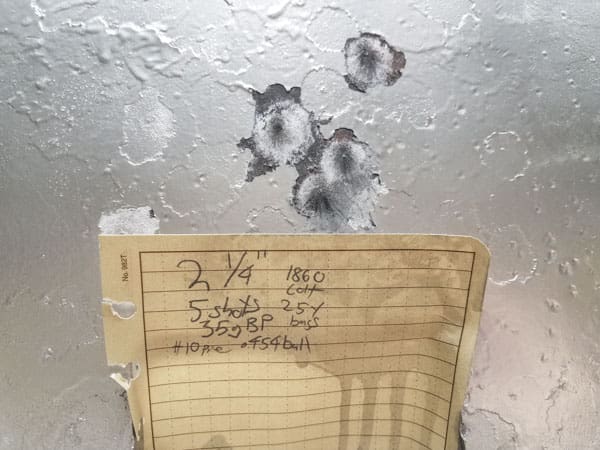
Setting the revolver down on bags, I was rewarded with 2 ¼” five round groups at 25 yards, with that high charge. I did that for 4 total groups, with the average remaining at 2 ¼”. I was pretty surprised by this level of accuracy, but I shouldn’t have been. After all, I’m measuring the powder myself for a consistent charge, and the soft lead ball is slightly oversized for the cylinders, ensuring a cylinder seal and a perfect fit for 8” of bore. Dropping back down to 25 grains of FFFg, I saw identical results in accuracy, with little change in the point of impact at that distance.
A cap and ball revolver can’t be expected to have the same level or reliability of a metallic cartridge gun. Everyone once in a while a cap would come dislodged and it would take a particularly hard cock of the hammer to turn the cylinder. Then, at about 50 rounds, I started to have inconsistent failures to fire. By that time the nipples had become clogged and needed to be cleaned out. A quick press with a pipe cleaner in and around all the nipples and the problem was solved.
This McColluch is inexpensive, but I imagine the expense will climb quickly with time. I seriously doubt the gun will require any major maintenance, but having only one of them is just stupid. It’s only six shots, and you really need to carry it on an unloaded chamber as you would any cap and ball revolver. That’s leaves just five shots, and there is no fast reload.
So, like the men who carried them for duty, I need at least two. I made my own powder horn, and powder measures, but really I should have a brass powder flask to be fully authentic. Then comes the leather, and good leather is expensive, and worth it. But all that is nothing compared to the care and feeding of a trained horse to shoot those pistols from. It adds up. I may have to stick with just the one and a good holster for a bit.
This is by no means my first black powder gun, but my first cap and ball revolver has been a great experience. I was surprised at how accurate it was, and how fast and easy it handled. It’s reliability is completely in keeping with the originals, and is absolutely combat worthy. It was one my hip for my last hunt, and will be heading out with me on my spring turkey and hog hunts. The added bonus — and it’s a big one — is the walk through the shoes, or sights as it were, of some of the heros of my land and my youth.
Specifications: Cimarron McColluch Colt Revolver
Caliber: .44
Barrel Length: 8 in.
Style: 1860 Army Fluted
Frame: Forged Steel
Grip: 1 Piece Walnut
Weight: 2.66 Lbs.
Price: $464.21
Ratings (out of five stars):
Appearance and style * * * * *
This I had to judge based on how well it matched the real thing. Without handling the museum example that still had the original wood, it would be hard to expect more. This gun was made to Cimarron Firearms’ specifications and they absolutely nailed it.
Reliability * * * *
Unacceptable for a modern pistol. Great, for what it is.
Accuracy * * * *
As accurate as any of my Blackhawks and the single action trigger is better than any of my revolvers, including my Smith Model 29 that’s had a quality trigger job. The super long sight radius makes it a champ. No one-inch groups, so no five stars, but it’s as good as or better than most of the modern pistols I’ve reviewed.
Overall * * * *
Plenty of power, fun to shoot, and a whole lot of local history. I had originally knocked this down to three stars because it wouldn’t go more than 50 rounds without a failure. My flintlock rifle, made in the early 19th century, won’t either. If it was 1861 I’d give this pistol four stars, so in 2017 it still gets four for being so good at it is. But if I were judging it on its similarity to the original, I’d dial it up to 11.

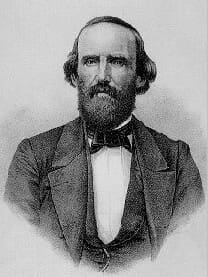
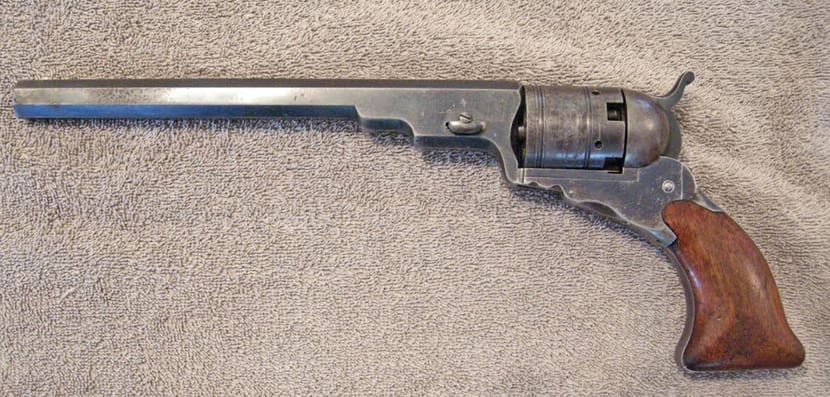




sweeeet. keep em coming JWT
“Keep em comin’…” Beat me to it.
You need to have it tuned. The arbor to barrel fit is critical. Most replica pistols like this will pound themselves apart because of the poor fit. Look into it. Also internals usually need to be cleaned up and smoothed.
Two years and hundreds and hundreds of rounds later, it’s still running like a champ, no modifications required.
By “tuning” I would still suggest an arbor adjustment to bring the point of impact down. On the Uberti revolvers, the arbor is usually a little short. This causes high firing. The fix is not complicated. Need to drill and tap the end of the arbor to use a allen set screw. Then adjust point of impact accordingly till it gets to zero.
“Riding directly into groups of (primarily) Comanches, the Hays Rangers would get as close as possible before emptying their revolvers, then pulling another one (or two) from their pommel holsters to fire again.”
So, in other words, the term should be “Texas Ranger Reload” instead of a “New York Reload”?
They are slightly different. “Reholster, draw next gun” is a little different than “drop to ground, grab next gun”.
This is top shelf quality content. Thanks for a great review of an awesome piece of history.
The tactics the Texas Rangers employed remind me a lot of the ones that German cavalry developed in the mid-16th century (the charge aspect, rather than the rapidly-discarded caracole). Of course, they had several single-shot wheel-locks rather than revolvers.
Loved this review. And the discussion of tactics reminded me of the incident in Winston Churchill’s autobiography when as a young soldier he participated in the last cavalry charge of the British Empire, in the Sudan against the Mahdi’s followers. (The massacre of Gordon and his men at Khartoum was a year or two earlier, and the Mahdi himself had died.) He was told he could have his choice of a saber or pistol for the charge, and he chose the pistol. As I recall, he was glad he did!
Nice. I love revolvers. I have a 1860 repro Italian colt that is fun to soot on 4th of July and whatnot. Did ya have any “pepperbox” shots? where the revolver touches off nearby cylinders? I use a cake decorator to “seal” them with Crisco to prevent that, it also weatherproofs the weapon for actual field/hunting use. Axle grease would be better but I’m cheap. Preasure on the loading lever can affect accuracy/shot consistency so try to use the same pressure on loading all cylinders. I liked using german hottter caps. I have used a .38 or .44 spent cartridge as a powder measure before getting a proper powder flask, and those can be tuned by adding a washer or two to the fill neck.
**** Warning **** if you go and shoot at a modern pistol range that does not sweep up the unused powder from modern firearms you can set off a slow burn on the ground, talk about range panic! This actually happened to me in Long Beach, Ca. at the firing range in the 90’s It was located on the back side of a water tank and the police used the other side. (LAPD?)
The cap and ball revolver can be used to shoot fish as well. (don’t do it)
They are a lot of fun to shoot and you can learn a lot about firearms and appreciate modern cartridge weapons a bit more. Hence my love of REVOLVERS!
Oh, forgot to mention that accuracy degrades the more you shoot. After about 40 shots you need to swab the bore out. The Yankees during the Civil War tried to make a bullet that had a hard zinc base to scrub the trash out but the were so-so on working. 1 shot in 12 was the recommended use for them. Williams Cleaner rifle bullet if your so inclined to read about them.
The Williams bullet can be purchased online. And other civil war musket lead bullets and even already made paper cartridges with the ball inside, ready for to add your powder.
https://www.papercartridges.com/
https://www.papercartridges.com/williams-bullets.html
Seems to me like Crisco would melt when the cylinder warmed up with use. I would stick to a more temperature-stabile sealant.
Never had any trouble with it. I’m sure there is something better to use.
Beeswax.
Peanut butter.
Bear grease.
Crisco is a very commonly used lubricant for black powder pistols. There is also Bore Butter, which is also soft, even runny. This is as intended. Black powder fouls the barrel quickly, and the Crisco (or other) keeps the fouling soft so that it can be quickly swabbed out while you are shooting. Second, the cylinder pin is also lubricated with a soft lube, as it is subject to fouling from the cylinder gap, which binds up the cylinder. Again, a simple swab fixes it.
I have used crisco for years. You are rght it melts, but it also works and better than many so called black powder lubes which tend to gum up the works very quickly and are very difficult to clean up after they are burned on.
or bacon.
CRAP! This is just not FAIR! I mean, a BBQ gun which includes a damn HORSE? That does it, I’m not inviting you!
Nice! Do they make it in the color case hardened and blue combo of your last test?
since it seems to be a very specific reproduction of a rare arm, I doubt it.
This gun is essentially an 1860 Colt Army with a different cylinder (nu flutes). If you want blue, they’ve got blue with case hardened frames. They usually run around $300. I bought one on sale from EMF (a Pietta) for $200 not long ago. I’ve written most of a review, but I haven’t gotten out to shoot it yet, or to take pictures as required by the review guidelines.
Try 2f powder if you have any. My guns probably avg 1/3 reduction in group size over 3f. Some it cuts in half.
+1. Because of the short barrel, these guns really benefit from the faster burning powder. Pyrodex P is a solid substitute if you can’t find True Black.
Swiss Black Powder, FTW
Reading your recitation of the combat tactics of Jack Hayes and his Rangers made me wonder if you’d read “Empire of the Summer Moon”.
If not, it’s an incredible, intriguing and highly readable tale of Texas history through much of the 1800’s, and talks plainly of the hard men & women (White & Commanche alike) who lived here during those years. You’d love it!
That, E of the SM, was an excellent read, one of my favorites covering Texas history. Some Rangers. A whole lot of Cavalry.
Not more than 10 times.
Anybody in a slave state should think about getting a cap and ball revolver. You don’t need to fill out a 4473 to get one so Big Brother need not know you have one. While they are not as good as a modern firearm they are just as deadly. Whenever Robert goes off on his “felons have a right to self defense” rants I always have pointed out that cap and ball revolvers are available for felons to defend themselves with.
That’s true for purchase, but in NY if you load it, or possess powder and ball as well as the pistol, it must be registered to a valid pistol permit.
Which is one reason among many for any sane person to not move to New York (and, if already living there, to move out!). Sad that the New England states area, where the American Revolution began, is one of the most restrictive regions as far as firearms ownership goes in this country (with the possible exception of Vermont). The first shots fired in the American Revolution were over…guess what…GUN CONTROL! After all, the British were on their way to confiscate arms and ammo from the colonists when they ran into the local militia at Lexington.
California felons cannot possess black powder firearms. The question comes up often because the Penal Code says that a black powder firearm is not a firearm unless it is loaded AND CAPPED. And that you can have them shipped to you UPS. Doesn’t matter, definite felony if you’ve been convicted of one.
JWT,
Great article! Very informative and well written as always.
As a proud Association / Foundation, and John B. Jones Masonic Rangering Company member, I want to Thank you for your support and dedication to serving as a board member of The Former Texas Rangers Association and Foundation.
Preserving Texas Ranger history and the tradition that is the heart and soul of the Lone Star State.
Courage, Determination, Dedication, Respect and Integrity. Character traits the Texas Rangers have adhered to for 193 years and counting.
Keep up the great work! ?
Sincerely,
J.M.
Edit to my reply above: *Major* John B. Jones.
What are peoples thoughts on the topstrap (Remington models) and the open tops like the colts. I’m leaning Remington more for the familiarity of a revolver having a topstrap but its not based on anything concrete. Hows the sighting using the hammer as the rear sight? Any thought are welcome.
Ruger built one that was really nice. Ruger Old Army .45. I’ve seen them for $300+ Somebody built a conversion to shoot black powder .45 colt too.
Today there is no real difference for the steel framed pistols because the steel is strong enough to handle anything you throw at it. Both Pietta and Uberti make replicas. The only difference is in the brass framed (and slightly cheaper ) guns, which I have read will stretch if loaded to full capacity. [ASFAIK, the only original brass framed guns were Confederat copies of the 1851 Colt or Whitney, made that way because of materials shortages.] The front sight is a small brass bead, and the notch is wide enough to see it, but whether that arrangement shoots to point of aim is a different story all together. As JWT mentioned, the guns typically shoot low, since they were originally, legend has it, sighted for 100 yards. However, to make them shoot closer to point of aim, the notch can be deepened with a file.
walker and colt, man what a pair.
Oh, man. I’ve been waiting for what feels like weeks for this review. You did not disappoint.
I’m not familiar with the history of Camp McCulloch, despite living about 10 minutes away. So the next time we run into each other, I’d appreciate a rundown of the place… we take our kids there to play in the creek quite often during the summer.
Boy howdy, I want one.
I live about 40 miles north of San Antone; the heart of many a Ranger sweep when the Comanche were making life impossible for settlers in these parts.
I think you’d really get a kick out of Jeffery Robenalt’s series: ‘Saga of a Texas Ranger’, ‘Star Over Texas’, and ‘The Bloody Frontier’. Robenalt covers all the major Ranger battles and campaigns against the Comanche (and some Kiowa and others) and of course against the Mexican regulars here and in the Mexican War over the border.
The Colts figure very heavily into those books, as they figured heavily into the lives of the Texas Rangers, and of course the Comanche warrior. First the Paterson…”White Eyes can make fire as many times as the fingers on a man’s hand”, and then especially with Sam Colt’s upgrades, those Colt Revolvers allowed two Rangers with a pair of them and a pair of extra cylinders, to take on a Comanche war party of 6-10 without breaking a sweat. Horse pistols and muzzle-loading rifles and shotguns were relegated to backup in the farmhouse.
Great books for all Texans, those Robenalt novels. Give ’em to a boy and he’ll never realize he was learning Texas history.
DMZ
Founder, AmericaAgain.net
(Proudly based in the heart of Texas)
Nice article, but a little off on the history. The Walker did not save the Colt firearms company. Rather, the PAtterson Arms company had failed and its assets sold in bankruptcy. Colt moved on to other (nonfirearm) projects, until he met up with Capt. Walker a few years later. Based on the design, and with backing from new financiers, Colt was able to rent space and buy back much of his original tooling in order to produce this gun. Not only did he build the guns for the Ranger contract, but he built an extra 100 for commercial sale. They were an immediate success, and led to the development of the Wells Fargo and later 1848 Pocket pistol, quickly followed by the 1851 Navy.
I should add that Ian of Forgotten Weapons has a nice short history of Colt that was posted very recently on The Firearms Blog. Or his YouTube channel.
well you forgot the part where eli whitney produced the first walkers after the contract was filled eli gave him the tooling to fullfill the second order
Greatly enjoyed your review. I have owned a number of cap and ball rifles and revolvers. I had a Walker repro. years ago and it was fun. I have had colt and remington repros and 2 Ruger old army stainless. Enyoyed every one of them. Keep up with the great reviews;; P.S. I met and spent time with Elmer Kieth before he passed.. I lived in Clarkston Washington at the time. He stated that he had done good work years before with some of the old Colt open tops. He shot rabbits on his ranch with a handgun. Try it sometime.
In my opinion and experience, the Pietta and Uberti loadings are EXTREMELY conservative. Call them “lawyer loadings” if you will, since these guns will not blow up at those powder loadings. My personal experience came from my first, A Pietta 1861 Colt Navy. The manual calls for a 12 gr. load, up to a maximum of 15 gr. When I went out to shoot it, I was all loaded up and ready to go, but the first shot jammed up the pistol–because the ball didn’t clear the forcing cone. At 20 grains it works just fine. Let’s add one other fact: the originals and the copies of the ’51 and ’61 have a maximum capacity of about 25 grains. Standard loads for the day were around 15 to 17 grains, but I’ve seen lighter paper cartridges. Most shooters play with the load until they get the accuracy they desire, which for most is right around 20 gr. Some people will load the chamber up to the rim and jam a ball over it, which isn’t accurate but makes a lot of smoke.
The Walker had a chamber capacity of 50 gr. Failures did occur, but metallurgy was not what it became only 15 years later. Most shot at 40 grains for accuracy, which is still a very powerful load that will down a horse. The 1860 Army has a chamber capacity of 40 gr., but the US Army standard load was 30 grains, as this increased accuracy and decreased recoil. (My reproduction has a measured chamber capacity of 45 gr because of the manner in which the chamber is bored, but that is a long story.) Because of the increase in recoil, the 1860s have a longer grip than the 181 or 1861 models. What I’ve read is that the most accurate loads are 28 to 30 grains.
The case capacity of the 1873 is 40 grains of black powder. However, the Army found that soldiers had difficulty with the recoil this produced, and cartridges were only filled to 35 grains. Even this was considered, in the day, to be a powerful load, and some would change out the grip (which is the same as the 1851 and 1861) to the longer 1860 grip.
A whole article could be written about the proper loading of a black powder pistol. So only a few brief comments if anyone is still reading.
First, a proper load requires that the powder be compressed, and second that the ball end up just inside the rim of the cylinder. To accomplish this, especially with lighter loads, one should fill up the chamber over the powder with a filler such as Cream of Wheat to about 1/2 the diameter of the ball below the rim, then load the ball. The Cream of Wheat also prevents chain fires caused by sparks entering the front of the chamber, and obviate the need to top off the load with Crisco or substitute. I personally am a fan of Wonder Wads on top of the CoW since they swab the bore and relube when fired. Cleaner too. (They will contaminate the powder if left in the gun for any period of time without CoW, but are fine if doing some shooting).
Second, the Italian nipples are not a true Number 11 Remington, and the Remington caps fit loosely. Many choose to pinch the No.11s to make them stay on, but this may be a cause of a chain fire. The problem is easily solved with Dynamit Nobel (yeah, that Nobel) caps with are 10.5s. Either that or aftermarket stainless nipples (which also have larger openings and may have more reliable ignition, but cause other issues).
Third, these guns must be taken down and washed with soap and water then lubed after shooting or they will rust. Black powder is corrosive, the substitutes also but less so.
Awaiting moderation? Am I being immoderate (again)?
Prolly because you said “nipple” (hee hee)..
Cap-and-ball Colts (and others) with a full complement of rear-of-cylinder ‘safety’ pins were designed to be carried fully charged, with the hammer nose notch resting on one of the pins. Carrying one with the hammer resting on a cap would be a bad idea, of course. This design was safer than that on the 1873 SAA, which relied on a fragile trigger nose/hammer notch ‘safety’ that broke regularly and required a ‘five-beans-only’ style of carry.
When the guns were in good shape, and the proper tight-fitting, high-quality caps were available, ‘loose’ caps were a rarity, and as they sealed the nipples well, flash-over from one bore to another (which happened when caps were sloppy or had to be crimped and bent to stay put, or the nipples were worn or corroded) was also rare. The steel ‘fences’ between the nipples also kept the chance of flash-over to a minimum.
In the era of common cap-and-ball use, there was little, if any, need to ‘Crisco’ things, as properly-cast balls (slightly oversize) made using a proper fitted mold were tight-fitting, and were swaged into the cylinder bores to correctly seal things. That was the real point to the long, hinged rammer, with its strong leverage–to get tight-fitting balls properly, safely sealed and seated in the chambers, not just to compress the powder.
The old habit of ‘hauling up and throwing down’ while firing a pistol wasn’t just for show; It came from the practice, with a cap-and-ball revolver, of raising the muzzle of the revolver after firing to vertical first, and THEN re-cocking the hammer, so that if large bits of broken cap fell off of the nipple, they wouldn’t fall down into the works (which they tended to do, if the gun was held horizontally while the cylinder rotated), but instead would fall out of the back, via the capping-clearance cut. Raising the muzzle before re-cocking slowed things down, but kept the gun working more reliably as a trade-off.
It’s always puzzled me that Federal and state governments, for the most part, think of cap-and-ball guns as some kind of harmless toy, since for most of the 19th Century they were just about State of the Art in killing folks, and time has not lessened their lethality in the least. In the case of the 1860 Army, as an example, if it would kill a horse at a hundred yards 150 years ago, it’ll do just fine on a man today.
Go figure.
In 1978 or 1979 I bought my first handgun, a .36 cal Spiller and Burr firing reproduction. It did not come with any instructions on how to load it or clean it. I also bought a brass flask and used its measuring cap not knowing that it was for a rifle and not knowing that a rifle takes a larger charge than does a handgun.
I was lucky that the cylinder did not explode. Eventually the brass frame bent and the cylinder would no longer rotate.
By the time I bought my next three black power revolvers during the 1980s, I had learned to measure a proper charge. Unfortunately, when I moved out of state I left them here in California in storage. I had cleaned them thoroughly and caked them with grease thinking that would protect them. Five or six years later I made a trip down here and took them back with me to Oregon. When I opened the box on my return to Oregon, all three were rusted beyond repair. They were so rusted one would have thought I had stored them in a shallow pool of salt water.
What I don’t understand is today’s prices. Then and now they are Italian made. These past ten years the Euro has plummeted against the dollar but the prices have skyrocketed. It isn’t as if the regulatory burden has increased or that we have had rampant inflation. In nearly every state, including California, they can be ordered online, the purchases do not have to go through an FFL.
It is as if brass and steel have become precious metals.
I am not surprised that your brass framed pistol “stretched” with max loads; they have a history of doing that. The steel don’t. I am surprised by the corrosion you suffered; I assume you stored them near salt water. I live inland and have no issues with rust on any one of the four BP revolvers I have. But you probably would not have “blown up the cylinder.” You can do this with smokeless, of course, but full loads of BP in a modern steel pistol are very unlikely to do so. Let me put it this way, at least according to a story I read about Elmer Keith, a man for whom no magnum was too powerful. he supposedly said that he got his hands on an original 1860 Army, and his load was to just below the rim, and he would squeeze a ball on top of that. He measured this l9oad as 37.5 or 39.5 grains by volume (I forget right off), and that he would spend an afternoon shooting at cans at 25 yards w2ith the gun between his knees for a support, his back against a fence post.
Mark N,
Alas, they were stored near the beach. I was not ignorant of the damage that could do which is why I thoroughly cleaned them and caked them with grease.
I am not one who favors “hot loads.” I particularly liked the low recoil from (15 grains?) compared to whatever I had been loading my revolvers with before. I had been filling the cylinders with power leaving just enough room for the ball which, when rammed into the cylinder, left just enough room for the felt wad.
Of course when I first started shooting, I had no idea that one was supposed to cover the cylinder with a felt wad or grease.
Fortunately, I was smart enough to know not to smoke while shooting and I did take a wire brush to each cylinder and let the gun cool prior to reloading so that’s something I guess. 😀
It makes me sick that Colt might be going bankrupt AGAIN.
Modern metallurgy makes these replica arms better guns. The design was the best they could do in 1860, but tolerances were not measured in thousandths, but 1/100 of an inch, then hand fitted. Parts did not interchange.
The cap & ball revolver can be mail ordered, it isn’t considered a “firearm” under Federal law, but many states consider any projectile weapon to be a firearm. Companies that deal in such arms won’t sell or deliver to such locations.
The Remington solid frame [ or the modern Ruger Old Army ] is stronger and have better sights.
Another recommendation for ‘Empire of the Summer Moon’ that covers a lot of the founding and need for Texas Rangers. The Ranger’s weren’t badasses from the start. They evolved into badasses after the Comanches ran circles around them in their early encounters. It came a a pretty high cost to them. It was Colt’s revolvers that gave them a decided advantage
One aspect that hasn’t been covered is Colt’s possible treasonous activities in getting that run of special revolvers to a person/state that was in open rebellion against the United States.
I used to make cartridges for my replica .44 1860 using Japanese tissue strips (I build model airplanes too) soaked in a potassium nitrate solution (saltpeter) and then hung to dry. When dry, I wrapped the strips around a waxed 3/8 inch wood dowel and glued the strip into a cylinder using clear nitrate dope (more model airplane stuff). When the paper cylinders had dried, I twisted one end, charged it with 25 grains of FFFG, then placed a .44 ball in the end and sealed it with more clear dope.
Placing the cartridges in the chambers and then ramming them only took seconds and they fired very dependably and accurately. I have no idea if the potassium nitrate infused paper added anything to the velocity but it was consumed completely and the chambers were clear and ready for reload immediately after firing.
Gear up as your favorite Delsin Rowe Vest. Slim Fit Leather Jackets brings this iconic jacket from animation to reality, especially for all the fans of this video game. Delsin Rowe is the main protagonist and playable character, a young Native-American man who later realizes he’s a Conduit with special powers.
Thanx for the review. Always a treat.
(My Beretta .22LR Neos space gun is hiding in the corner, whimpering in embarrassment)
Comments are closed.